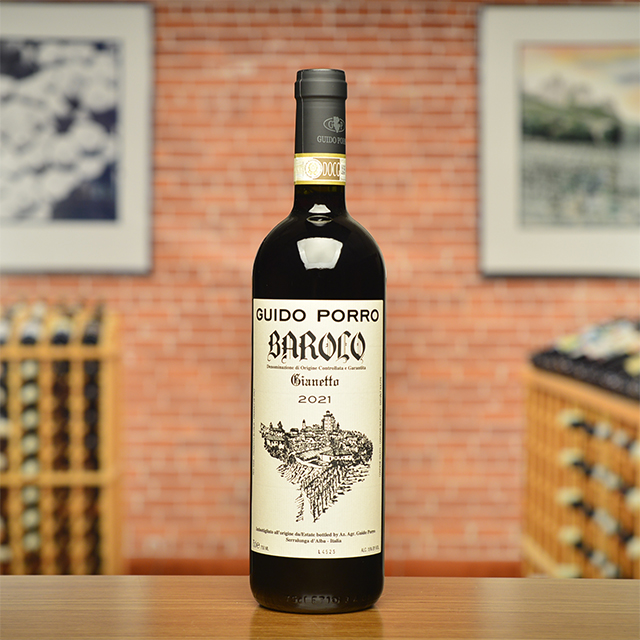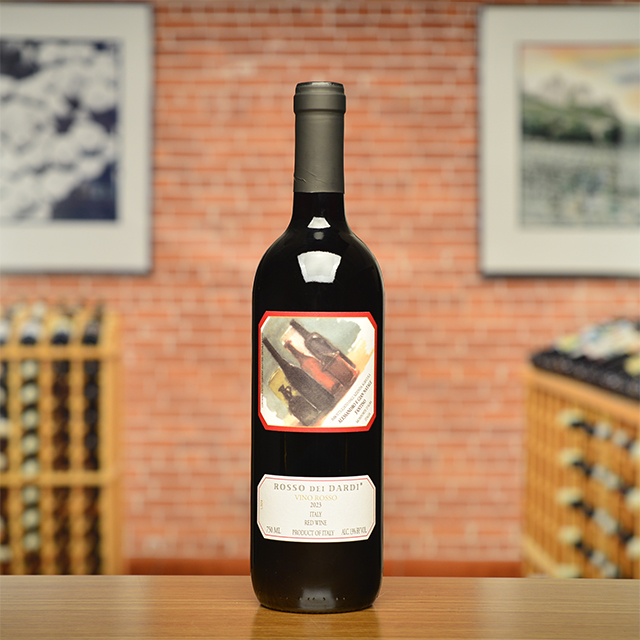Notify me
2016 Barolo “Serradenari”
Giulia Negri
At 520 meters above sea level, the Serradenari cru is home to the highest vineyards in the Barolo appellation, with sweeping views of the Langhe hills and snowcapped Alps on the horizon. I can’t imagine it would get old working amid this scenery, but that’s not to say the work is light. Giulia’s painstaking attention to detail in these sandier-soil parcels, and deliberate choices in the cellar, result in wines with a fine grain, spiced tannins, and a celestial nose of peony and rose petal.
—Jane Berg
| Wine Type: | red |
| Vintage: | 2016 |
| Bottle Size: | 750mL |
| Blend: | Nebbiolo |
| Appellation: | Barolo |
| Country: | Italy |
| Region: | Piedmont |
| Producer: | Giulia Negri |
| Vineyard: | 1 ha, planted in 2003 |
| Soil: | Clay, Loam, Marl |
| Farming: | Organic (certified) |
| Alcohol: | 14% |
More from this Producer or Region

2024 Langhe Freisa “alla mia Gioia”
Italy | Piedmont
It is bone-dry with aromas of dark forest berries, with a finish that is both grippy and slightly frothy. Pair this zippy red with salami.

2021 Barolo “La Tartufaia”
Italy | Piedmont
The wines produced from La Tartufaia are textbook examples of classically structured Barolo typical of the area.

2021 Barolo “Marassio”
Italy | Piedmont
Unusual for La Morra, the soil here is rich in limestone with veins of chalk, giving Giulia’s most dense, profound, earth- and mineral-driven Barolo.

2021 Barolo “Gianetto”
Italy | Piedmont
The Barolos of Serralunga are renowned for their power and longevity, and while Porro’s Gianetto is not the unyielding, tannic beast of old, it will certainly benefit from a few years in your cellar.

2024 Moscato d’Asti “Sorì Gramella”
Italy | Piedmont
Who could resist such a heavenly ambrosia, with its scent of kaleidoscopic spring wildflowers, fragrant citrus blossoms, and succulently ripe grapes?

2021 Barolo “Serradenari”
Italy | Piedmont
Giulia’s Serradenari bottling is a beautiful, bracing, tightly wound, and vibrant Nebbiolo full of cherry, rose petals, and citrus.

2022 Dolcetto di Diano d’Alba “Sörì Cristina”
Italy | Piedmont
Supple, pretty notes of freshly crushed blackberries and raspberries—it will pair well with pretty much anything.

2024 Vino Bianco
Italy | Piedmont
Dry and low in alcohol, with lip-smackingly crisp fruit and a gentle spritz, this quaffer is as unpretentious as its maker.

2023 Erbaluce di Caluso “Tredicimesi”
Italy | Piedmont
Both generous and chiseled, it evokes orchard fruit, citrus, and has an irresistibly saline finish.

2023 Rosso Dei Dardi
Italy | Piedmont
Perfumed Nebbiolo fruit and tender tannins encourage pulling the cork just for the sake of quenching one’s thirst.
About The Producer
Giulia Negri
In the heart of the Serradenari cru of La Morra—the highest point in the Barolo zone, with vineyards culminating at 536 meters above sea level—Giulia passionately pursues her goal of crafting Barolo with a Burgundian sensibility. In fact, she even inherited small parcels of Chardonnay and Pinot Nero that her father planted on the estate’s cooler, north-facing sites, allowing her to pay tribute to the great wines of the Côte d’Or through the lens of Piemontese soil.
But Nebbiolo reigns in these parts, and Serradenari yields a Barolo of regal pedigree. The elevation, coupled with a complex mosaic of soils unique to this part of the Langhe, sets the stage for Giulia to create Barolos marrying delicate floral aromas and elegant fruit with a deep mineral foundation. With fine-grained, tightly knit tannins, her seductive wines charm in their youth but have the structure for serious bottle aging.
About The Region
Piedmont

Kermit’s love affair with the great reds of Piemonte dates back to the early days of his career: the very first container he imported from Italy, in fact, featured legendary 1971 and 1974 Barolos from Vietti and Aldo Conterno. Regular visits since then have seen our portfolio grow to now twelve Piemontesi estates, with a strong focus on the rolling hills of the Langhe.
Nebbiolo rules these majestic, vine-covered marl slopes, giving Italy’s most mystifyingly complex, nuanced, and age-worthy reds. When crafted via traditional production methods—long macerations and extensive aging in enormous oak botti—the powerful, yet incredibly refined Barolos and Barbarescos provide haunting aromatics of tar, raspberry, incense, tea, roses, and more. At times austere in their youth but well worth the wait, they pair beautifully with the hearty local cuisine starring veal in many forms, braised beef, pastas like tajarin and agnolotti, and of course, Alba’s famous white truffles.
Surrounded by mountains on three sides, Piemonte’s climate is continental, with baking hot summers and cold winters. Nebbiolo is only part of the story here: juicy, fruity Barberas and Dolcettos represent the bread and butter throughout the region, and other native grapes like Freisa, Croatina, and the white Arneis are also noteworthy. Value abounds in the Monferrato, while Alto Piemonte also has its share of thrills to provide.
Every corner of Piemonte is rich with tradition, especially when wine is concerned. It’s no wonder we have been singing the region’s praises for over forty years.
More from Piedmont or Italy
2022 Barbaresco “Vicenziana”
Silvio Giamello Italy | Piedmont
2022 Dolcetto d‘Alba “La Costa” MAGNUM
Piero Benevelli Italy | Piedmont
2020 Barolo “Ravera di Monforte”
Piero Benevelli Italy | Piedmont
2024 Dolcetto d’Alba “La Costa”
Piero Benevelli Italy | Piedmont
2024 Langhe Freisa “alla mia Gioia”
Piero Benevelli Italy | Piedmont
2024 Vino Rosso
Tintero Italy | Piedmont
2021 Barolo “Vigna Santa Caterina”
Guido Porro Italy | Piedmont
2024 Vino Rosato
Tintero Italy | Piedmont
Vermouth di Torino Bianco “Aperitiv dla Tradission”
Bèrto Italy | Piedmont
2024 Vino Bianco
Tintero Italy | Piedmont
2023 Erbaluce di Caluso “Le Chiusure”
Cantina Favaro Italy | Piedmont
2023 Erbaluce di Caluso “Tredicimesi”
Cantina Favaro Italy | Piedmont
2022 Barbaresco “Vicenziana”
Silvio Giamello Italy | Piedmont
2022 Dolcetto d‘Alba “La Costa” MAGNUM
Piero Benevelli Italy | Piedmont
2020 Barolo “Ravera di Monforte”
Piero Benevelli Italy | Piedmont
2024 Dolcetto d’Alba “La Costa”
Piero Benevelli Italy | Piedmont
2024 Langhe Freisa “alla mia Gioia”
Piero Benevelli Italy | Piedmont
2024 Vino Rosso
Tintero Italy | Piedmont
2021 Barolo “Vigna Santa Caterina”
Guido Porro Italy | Piedmont
2024 Vino Rosato
Tintero Italy | Piedmont
Vermouth di Torino Bianco “Aperitiv dla Tradission”
Bèrto Italy | Piedmont
2024 Vino Bianco
Tintero Italy | Piedmont
2023 Erbaluce di Caluso “Le Chiusure”
Cantina Favaro Italy | Piedmont
2023 Erbaluce di Caluso “Tredicimesi”
Cantina Favaro Italy | Piedmont
Kermit once said...

Kermit once said...
A good doctor prescribed the wine of Nuits-Saint-Georges to the Sun King, Louis XIV, when he suffered an unknown maladie. When the king’s health was restored the tasty remedy enjoyed a vogue at court. Lord, send me a doctor like that!
Inspiring Thirst, page 117
















